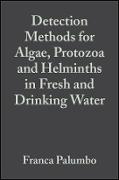- Start
- Detection Methods for Algae, Protozoa and Helminths in Fresh and Drinking Water
Detection Methods for Algae, Protozoa and Helminths in Fresh and Drinking Water
Angebote / Angebote:
Providing a comprehensive approach to water quality measurement, Detection Methods for Algae, Protozoa and Helminths in Fresh and Drinking Water is the second book in the Water Quality Measurement Series. Potential disease-causing biological agents such as Algae, Protozoa and Helminths exist throughout the entire water cycle. These agents, which can be of natural or anthropogenic origin, have varied potential impact and significance in the water cycle. This book focuses on the analytical aspects related to epidemiology, toxicology, sanitary engineering and plant technology to provide an integrated and clear strategy for carrying out surveillance, quality control, prevention and remedial measures. The book provides coverage of: Hygienic and health aspects of biological agents within fresh and drinking water Counting methods for Algae, Protozoa and Helminths Methods for cyanobacteria toxin detection Methods for extraction and determination of chlorophylls Viability of Cryptosporidium oocysts and Giardia cysts Laboratory requirements and quality assurance The book also addresses the importance of: Epidemiological and other catchment area information Environmental context Waterwork structure Treatment plant configuration Sampling strategy and methodology. Water Quality Measurement Series This series provides a comprehensive coverage of the analytical techniques used for the measurement of substances in water from sampling through to laboratory analysis. The scope of the series encompasses topical issues including quality assurance, standard procedures, and the best practices in measuring water quality, from surface and drinking water to coastal and wastewater. The techniques will be discussed in relation to current legislation and guidelines. The series aims to offer workable answers to specific practical issues related to measurements of the water cycle quality, using a comprehensive and scientifically sound approach.
Folgt in ca. 15 Arbeitstagen
